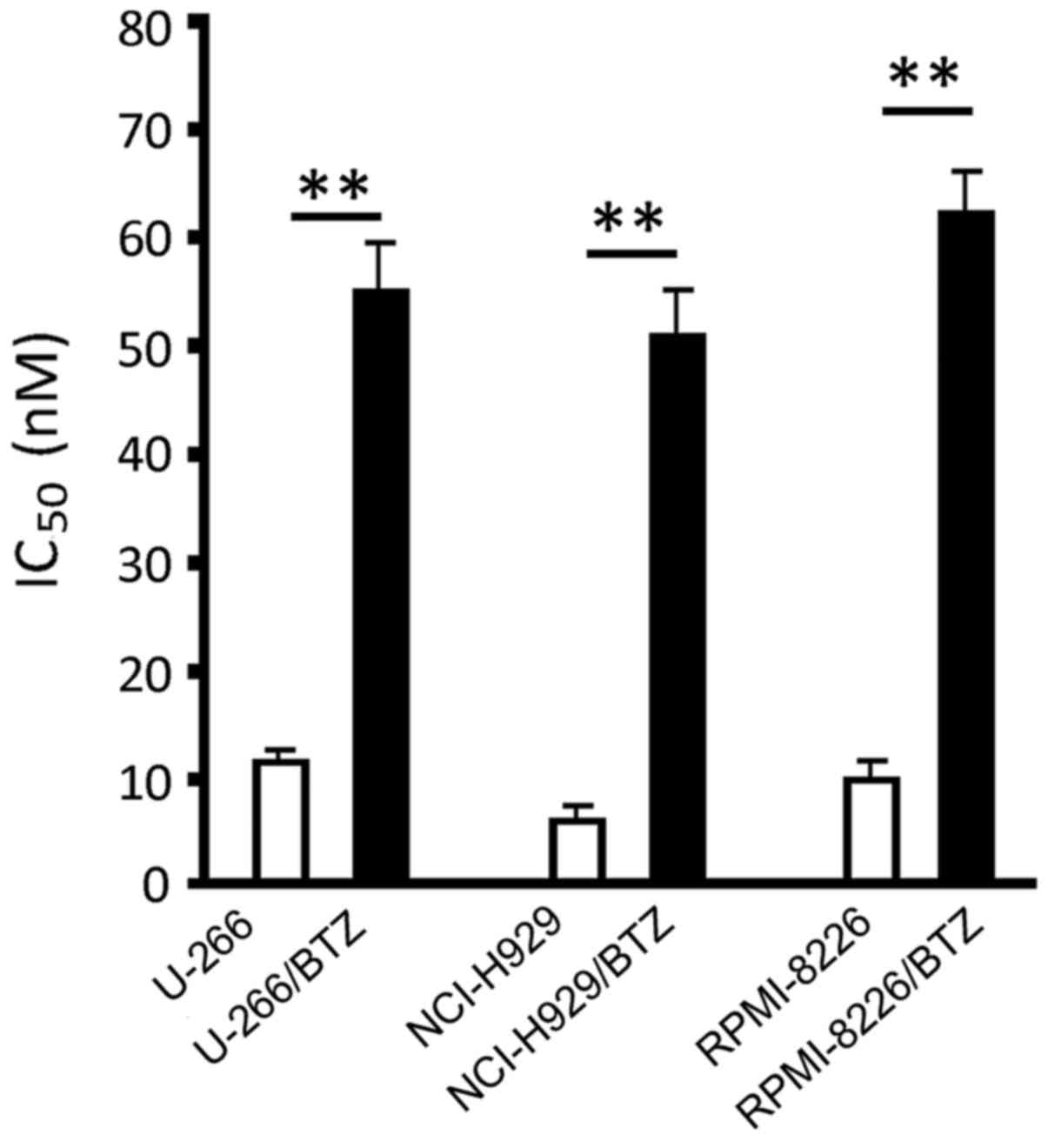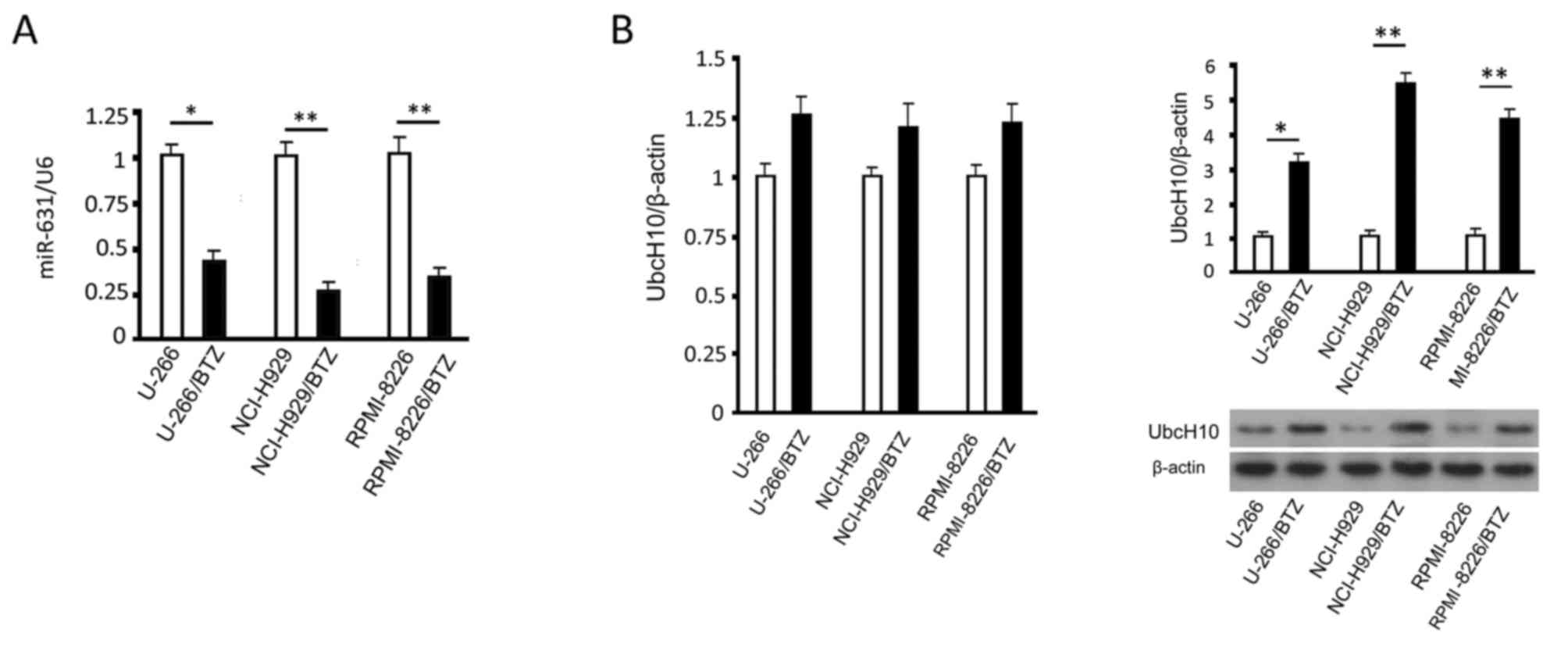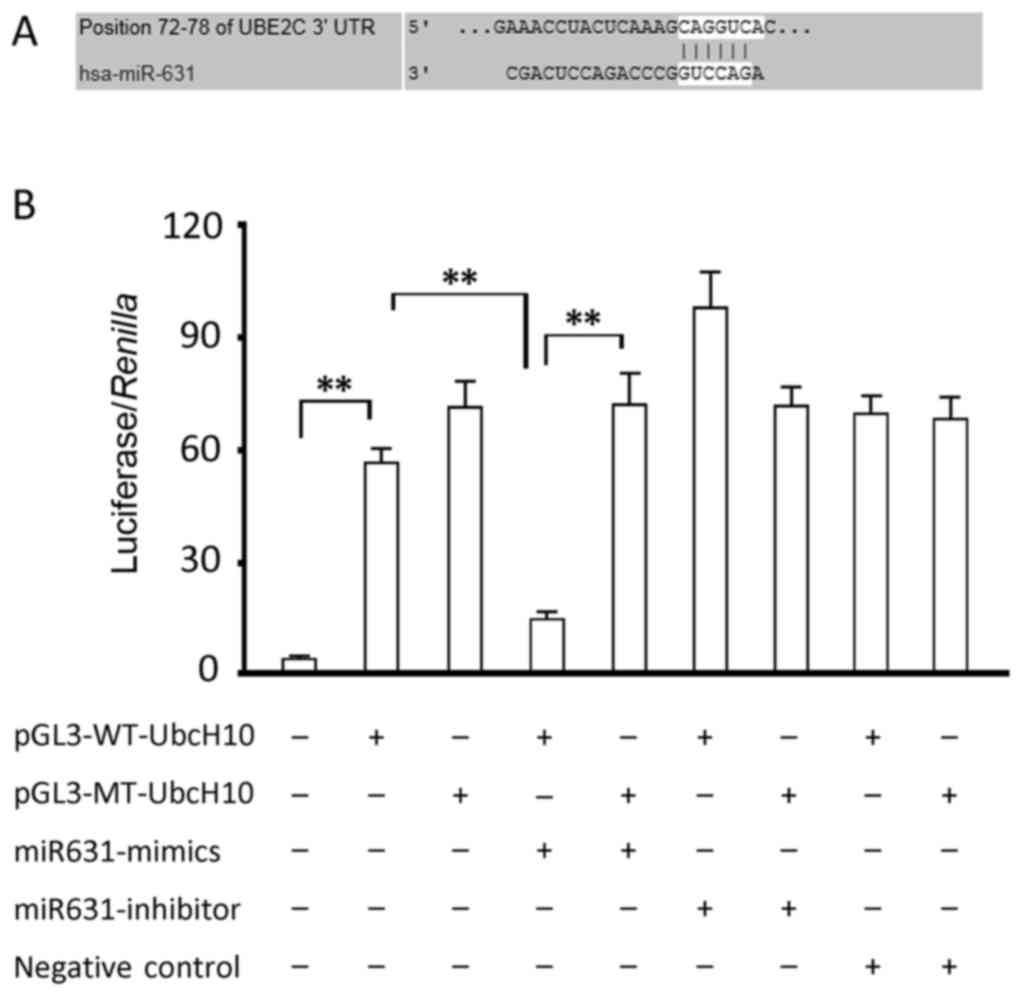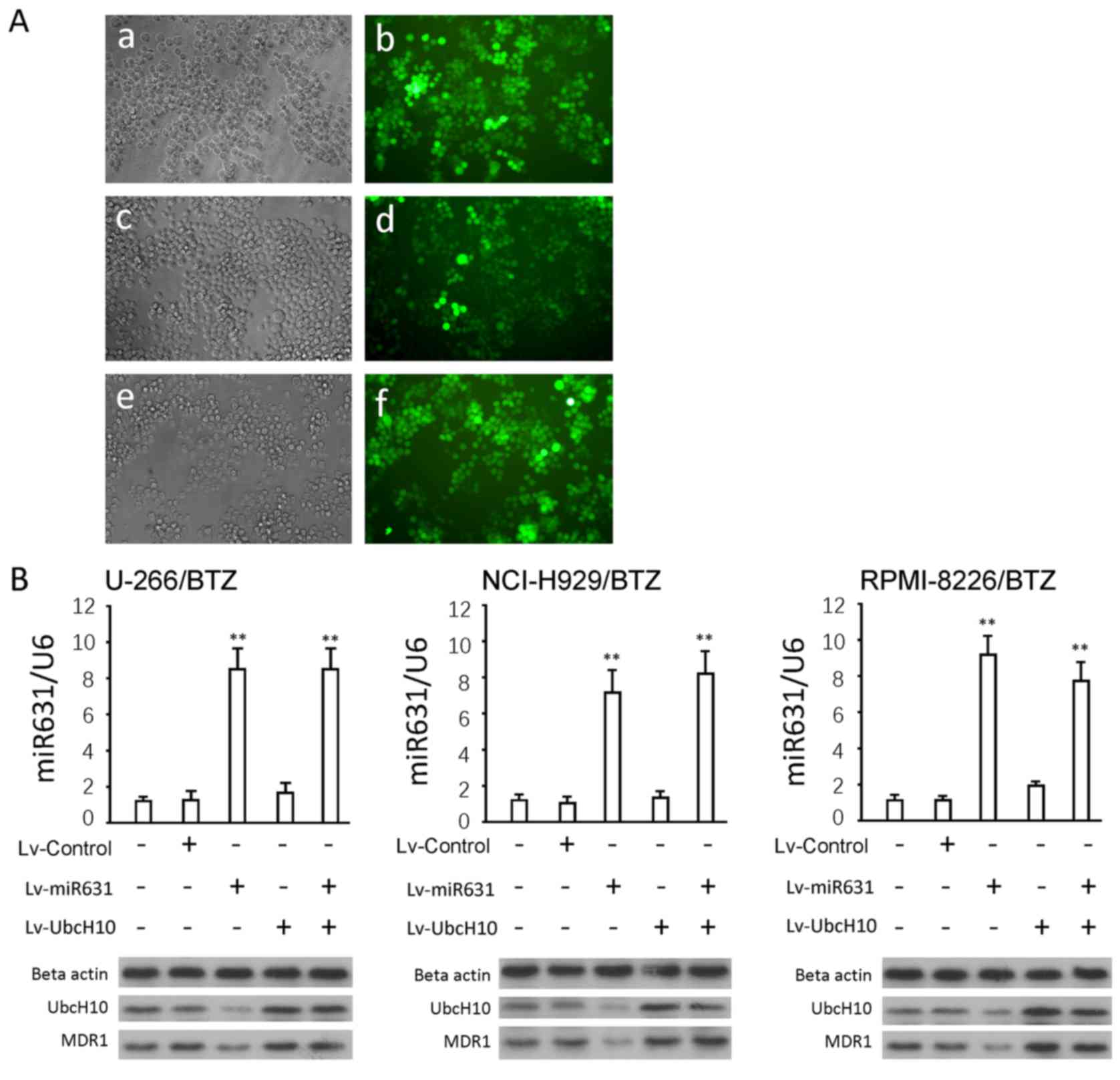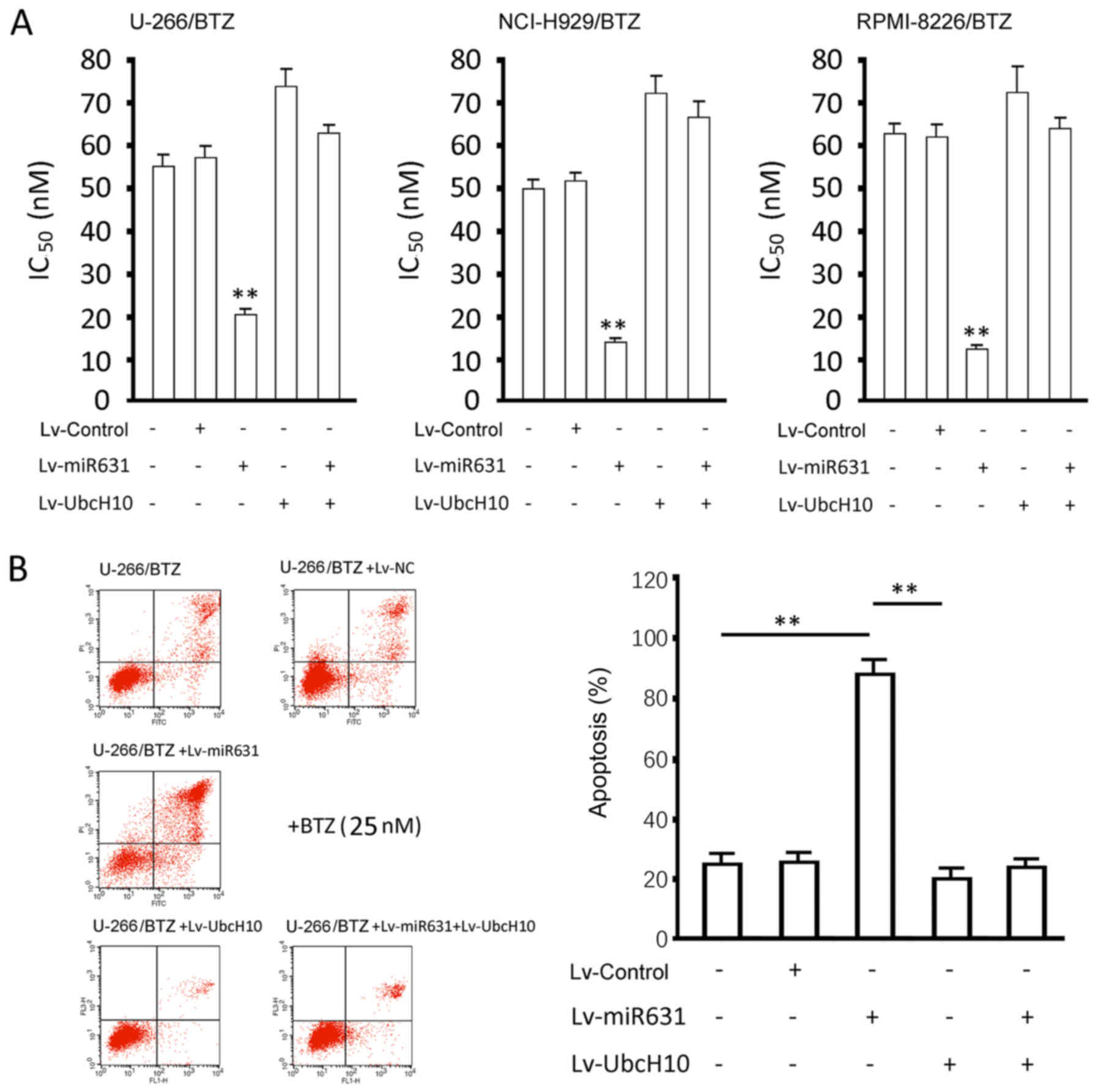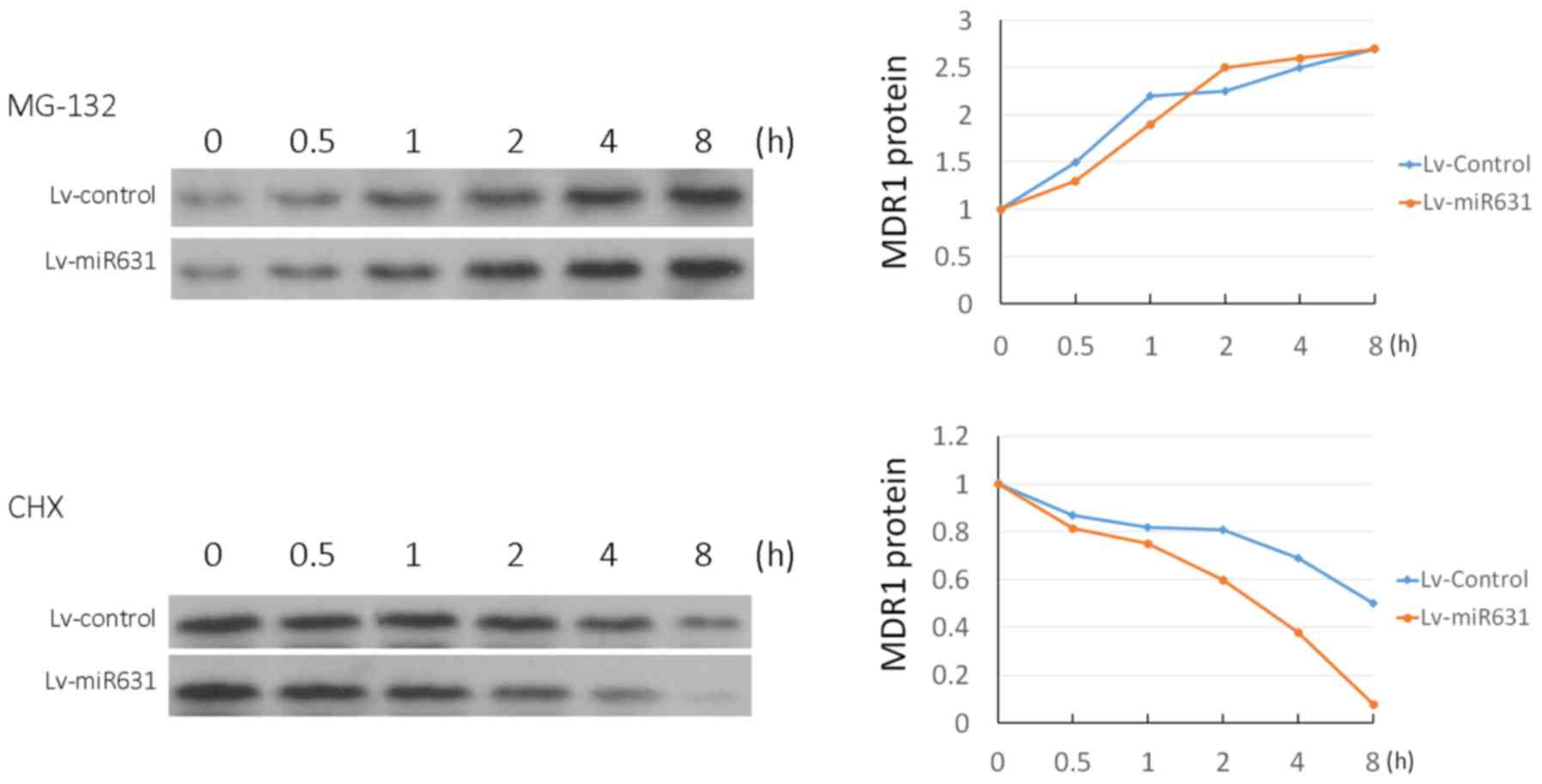hsa-miR-631 resensitizes bortezomib-resistant multiple myeloma cell lines by inhibiting UbcH10
- Authors:
- Published online on: December 14, 2016 https://doi.org/10.3892/or.2016.5318
- Pages: 961-968
Abstract
Introduction
Multiple myeloma (MM) is the second most common hematologic malignancy, with an incidence higher than that of acute leukemia. Although most MM patients are sensitive to initial chemotherapeutic treatments, relapse often occurs due to acquired drug resistance (1,2). The introduction of bortezomib (BTZ) represented a breakthrough in the treatment of MM. Chemotherapy regimens based on BTZ have become first-line recommendations for MM patients with untreated, relapsed or refractory myeloma, including patients who are eligible for autologous hematopoietic cell transplantation (3,4). BTZ resistance has a strong impact on the clinical effectiveness of MM treatments. Therefore, determining the process by which BTZ resistance develops in MM and searching for effective regimens to overcome resistance are critical research areas (5).
In the present study, we established three BTZ-resistant cell lines, U-266/BTZ, NCI-H929/BTZ and RPMI-8226/BTZ, by using gradual induction. We examined the mRNA and protein expression levels of UbcH10 in the resistant and their parental cells. The data showed that UbcH10 protein was significantly increased in the resistant cell lines while mRNA was slightly increased, suggesting an inactivation of the post-transcriptional regulation of UbcH10. Since microRNAs (miRNAs) are a typical mechanism for post-transcriptional regulation (6,7), we searched for miRNAs with a binding site on the 3′-untranslated region (3′UTR) of UbcH10. We then quantitatively measured the miRNAs in the resistant and parental cells. The results indicated that hsa-miR-631 was negatively correlated with the UbcH10 protein. A luciferase reporter assay verified that hsa-miR-631 was able to bind to UbcH10-3′UTR and inhibit protein expression through the seed site. The results suggest that the inactivation of UbcH10 regulation by hsa-miR-631 may be a molecular mechanism for resistance in MM cell lines. This study examined whether hsa-miR-631 was abnormally expressed in BTZ-resistant MM cell lines, whether abnormal UbcH10 expression caused by abnormal hsa-miR-631 expression was a critical factor in BTZ resistance, whether MDR1 is involved in UbcH10-associated BTZ resistance and whether the overexpression of hsa-miR-631 may reduce or reverse BTZ resistance in MM cell lines.
Materials and methods
Cell culture
Three MM cell lines, U-266, NCI-H929 and RPMI-8226, were purchased from the Chinese Academy of Sciences Cell Bank (Shanghai, China). Cell lines were maintained in RPMI-1640 medium containing 10% fetal bovine serum (FBS) (both from Invitrogen, Carslbad, CA, USA). The viral packaging cell line 293T was purchased from American Type Culture Collection (ATCC; Manassas, VA, USA) and maintained in Dulbecco's modified Eagle's medium (DMEM) supplemented with 10% FBS. All cells were incubated at 37°C in a humidified 95% air and 5% CO2 incubator. U-266, NCI-H929 and RPMI-8226 cells were cultured in a semi-suspension and passaged by centrifugation; 293T cells were adherent and passaged by trypsin digestion.
Establishment and verification of BTZ-resistant MM cell lines
Three selected MM cell lines, U-266, NCI-H929 and RPMI-8226 were cultured with BTZ in a gradient of increased concentrations starting from 0.1 nM and doubling every three passages, i.e., 0.1, 0.2, 0.4, 0.8, 1.6, 3.2, 6.4, 12.8, 25.6 and 51.2 nM. Cells were cultured in a medium containing 51.2 nM BTZ for two additional passages. These cell lines were named U-266/BTZ, NCI-H929/BTZ and RPMI-8226/BTZ. The resistant and parental cells were seeded in 96-well plates at 1×105 cells per well, and medium containing BTZ was added at a final concentration of 1, 2, 4, 8, 16, 32 and 64 nM for a period of 48 h. Cell Counting Kit-8 (CCK-8) assay was employed to determine cell inhibition by BTZ and to calculate the drug dose causing 50% growth inhibition (IC50) values. Meanwhile, the resistant and parental cells (1×106 each) were harvested for total RNA and protein extraction, followed by real-time PCR and western blotting to measure the UbcH10 mRNA, hsa-miR-631 and UbcH10 proteins.
Plasmid construction
Construction of luciferase reporter vectorsHuman UbcH10 3′-UTR (259 bp) was amplified from cDNA obtained through the reverse transcription of the total RNA of 293T cells, using the primers (Forward/Reverse) 5′-GCTCTAGAGAAACCTACTCAAAGCAG-3′ and 5′-GCTCTAGAACCACAGCTCAAGATAAA-3′. The amplification parameters were 32 cycles of denaturation at 95°C for 10 sec, annealing at 58°C for 30 sec and extension at 72°C for 30 sec. The product was then digested with XbaI and inserted into the pGL3-promotor vector (Promega Corp., Madison, WI, USA). The seed region was mutated by point mutation from 5′-CAGGTC-3′ to 5′-TCGCAG-3. The resulting vectors were named pGL-WT-UbcH10 and pGL-MT-UbcH10.
Construction of cDNA expression vectorThe CDS sequence of human UbcH10 (NM_007019.2) was amplified using the primers (Forward/Reverse) 5′-GGAATTCGCCACCATGGCTTCCCAAAACCGCG-3′ and 5′-CGGGATCCTCAGGGCTCCTGGCTGGTG-3′, which contained an EcoRI cutting site and Kozak sequence and a BamHI cutting site, respectively. The cDNA was prepared by reverse transcription of RNA isolated from 293T cells. The PCR product was digested and cloned into a pcDH-CMV lentiviral expressing vector. Finally, the recombinant vector was named pcDH-UbcH10.
Construction of the miR-631 expression vectorHuman genomic DNA was extracted from 293T cells and used for amplification of the template of the precursor sequence of miR-631. The primers (Forward/Reverse) used were 5′-GGAATTCTGGCATGCCATAGCAGCGCAG-3′ and 5′-CGGGATCCCTCCCATCTAAGCTTCCCAAAGTGT-3′. The PCR product was digested using EcoRI and BamHI, ligated into linear pCDH-EF1-GFP vector (System Biosciences, Mountain View, CA, USA) and transformed into DH5α competent cells. The obtained vector was called the pmiR-631 vector. The products of the vectors were confirmed by DNA sequencing. Endotoxin-free DNA was prepared in all cases.
Lentivirus packagingOne day before transfection, 293T cells were seeded into 10-cm dishes. Then, 2 µg of each pmiR-631 or pcDH-UbcH10 vector and 10 µg pPACK Packaging Plasmid Mix (System Biosciences) were co-transfected using Lipofectamine 2000 (Invitrogen) in accordance with the manufacturer's instructions. The medium was replaced with DMEM plus 1% FBS. Forty-eight hours later, the supernatant was harvested and cleared by centrifugation at 5,000 × g at 4°C for 5 min, and it was passed through a 0.45-µm pore PVDF membrane. The virus titre was determined by gradient dilution. The packaged lentiviruses were named Lv-miR631 or Lv-UbcH10.
Verification of the binding site of hsa-miR-631 on UbcH10-3′UTR by luciferase reporter assayTargetScan was used to predict the theoretic target (seed region) of miR-631 in mRNA sequence of UbcH10 (NM_007019.3). Chemically synthesized miR631-mimics, inhibitor and negative control (NC) were obtained from Shanghai Sangon Biotech Co., Ltd. (Shanghai, China).
293T cells were transfected with the miR631-mimics, inhibitor or NC as well as pGL-WT-UbcH10 and pGL-MT-UbcH10 using Lipofectamine 2000 according to the manufacturer's instructions. Forty-eight hours after transient transfection, the cells were harvested and luciferase assays were performed. The relative luciferase activities (ratios of firefly and renilla luciferase activity) of lysates were measured using a Dual-Luciferase Reporter system (Promega Corp.).
Effects of expression of miR-631 or UbcH10 on BTZ resistance and MDR1 expression in MM cellsThe cells were divided into five groups: control, Lv-control, Lv-miR631, Lv-UbcH10, and Lv-miR631/Lv-UbcH10. The cell lines in logarithmic phase U-266/BTZ, NCI-H929/BTZ and RPMI-8226/BTZ were seeded into 6-well plates at 5×105 cells per well. Lentiviral solution at an MOI of 30 was added the next day. Seventy-two hours later, the infection efficiency was examined by observation of fluorescent markers. The cells were divided into three parts: one was seeded into 96-well plates and cultured in media containing various concentrations of BTZ (1–32 nM). After 48 h, a CCK-8 assay was used to calculate the IC50 values of BTZ before and after genetic intervention. Next, other cells were cultured in a medium containing 25 nM BTZ, and apoptosis was examined by double staining assay after 48 h. The third group of cells was collected and subjected to extraction of total RNA and protein, followed by real-time PCR and western blotting to measure the miR-631 and UbcH10 RNAs and the UbcH10 and MDR1 proteins, respectively.
Assessment of cell viability and IC50 valuesThe three cell lines and their genetically engineered lines were seeded in 96-well plates at 5×104 cells per well, and BTZ was added to a final concentration at 1, 2, 4, 8, 16 or 32 nM for a period of 48 h, followed by a CCK-8 assay for cell viability. Briefly, 10 µl CCK-8 solution was added, and the cells were cultured under normal conditions for an additional 4 h before measuring absorbance at 450 nm. The cell inhibition ratio was calculated, based on the IC50 values at 48 h.
Detection of apoptosisSeventy-two hours after viral infection, U-266/BTZ, NCI-H929/BTZ and RPMI-8226/BTZ cells were seeded into 6-well plates at 1×105 cells per well in medium containing 10 µM BTZ and were cultured for 48 h. The cells were collected and measured for apoptosis using flow cytometry (FACSCalibur) after treatment using the Annexin V-FITC Apoptosis Detection kit II (cat no. 556570) (both from BD Biosciences).
Effect of hsa-miR-631 overexpression on the half-life of MDR1 protein in resistant MM cellsSeventy-two hours after viral infection, U-266/BTZ cells were re-suspended in RPMI-1640 medium with 10% FBS, reseeded to 6-well plates at 2×105 cells per well and cultured overnight. Then, the medium was replaced with serum-free RPMI-1640 medium containing either 50 µM MG132 or 100 µg/ml cycloheximide (CHX), and the cells were incubated under normal conditions. The cells were collected at 0, 1, 2, 4 and 8 h after the drug treatment, and total protein was extracted for MDR1 detection by western blotting.
Measurement of mRNA levelsTotal RNA was isolated with TRIzol reagent (Invitrogen) according to the manufacturer's instructions. RNA was reverse transcribed into cDNA using M-MLV Reverse Transcriptase and oligo(dT)18 primer (both from Takara Bio, Inc., Otsu, Japan). The following specific primers (Forward/Reverse) were used in quantitative PCR of human UbcH10 and β-actin: UbcH10, 5′-AAGACCTGAGGTATAAGCTC-3′ and 5′-CCACTTTTCCTTCAGGATGTC-3′; β-actin, 5′-CCTGTACGCCAACACAGTGC-3′ and 5′-ATACTCCTGCTTGCTGATCC-3′. The lengths of the amplified products were 143 and 211 bp. Real-time PCR was performed using SYBR® Premix Ex Taq™ kit and the TP800 system (both from Takara Bio, Inc.). cDNA from 200 ng total RNA was used as the template. The PCR reactions were conducted using 40 cycles of denaturation at 95°C for 10 sec, annealing at 60°C for 20 sec and extension at 72°C for 20 sec.
To test the miR-631 levels, total RNA (2 µg) was used for cDNA preparation with the M-MLV reverse transcription kit and specific primers: U6 snRNA (NM_001101.3), 5′-TACCTTGCGAAGTGCTTAAAC-3′; and miR-631, 5′-GTCGTATCCAGTGCGTGTCGTGGAGTCGGCAATTGCACTGGATACGAGGAGA-3′. RNA contents were detected using fluorescent dye PCR (Takara Bio, Inc.) in accordance with the manufacturer's instructions. The following primers (Forward/Reverse) were used for quantification of human U6 snRNA and miR-631: U6 snRNA, 5′-GTGCTCGCTTCGGCAGCACAT-3′ and 5′-TACCTTGCGAAGTGCTTAAAC-3′, which produced a segment of 112 bp; and miR-631, 5′-GCCGGCGCCCGAGCTCTGGCTC-3′ and 5′-AGACCTGGCCCAGACCTCAGC-3′, which produced a segment of 73 bp. The PCR systems included Takara SYBR Premix Ex Taq 10 µl, forward and reverse primers (20 µM) 0.2 µl each, and cDNA 2 µl added with dH2O to 20 µl. The cycling parameters were 40 cycles of denaturation at 95°C for 10 sec, annealing at 60°C for 20 sec and extension at 72°C for 20 sec.
The mRNA levels of UbcH10 were normalized to the expression of an endogenous housekeeping gene, β-actin, using the ΔΔCt method. U6 snRNA was used as a reference to normalize the miR-631 levels using the 2−ΔΔCt method. Each RNA sample was run in triplicate.
Detection of proteinsProtein was extracted from the cells using M-PER mammalian protein extraction reagent (Pierce Biotechnology, Inc., Rockford, IL, USA). Equal amounts of protein (25 µg per lane), as estimated by a bicinchoninic acid (BCA) protein assay kit (Pierce Biotechnology, Inc.), were loaded onto (11%) SDS-PAGE gels and transferred onto nitrocellulose membranes. The blots were probed with a monoclonal antibody against human UbcH10 (1:1,000), MDR1 (1:300) and β-actin (1:1,200), followed by the secondary HRP-conjugated anti-mouse/rabbit antibody (Santa Cruz Biotechnology, Inc., Santa Cruz, CA, USA). After washing, bands were detected by chemiluminescence and imaged with X-ray film, and relative optical densities were analyzed with the image processing software (TotalLab). Relative contents of proteins were calculated by dividing the optical density of the target band with the optical density of the β-actin band.
Data analysisAll data are expressed as the mean ± SD and were analyzed by one-way ANOVA. Least significant difference (LSD) was used for multiple comparisons between any two means. P-values <0.05 were considered statistically significant. All statistical analysis was performed using SPSS 13.0 software.
Results
Establishment and confirmation of BTZ-resistant myeloma cell lines
We established the three BTZ-resistant cell lines U-266/BTZ, NCI-H929/BTZ and RPMI-8226/BTZ by gradually increasing the concentration of BTZ in the culture medium for ~3 months. The results of IC50 measurement showed that the IC50 values in the U-266/BTZ, NCI-H929/BTZ and RPMI-8226/BTZ cells increased from 11.10±1.24, 6.08±0.71 and 10.02±1.62 nM in their parental cells to 55.62±4.88, 49.12±4.32, and 61.21±5.82 nM, respectively. These figures represented statistically significant differences between the resistant cells and their parental cells (P<0.01) (Fig. 1).
Examination of miR-631 and UbcH10 expression in resistant myeloma cells
Quantitative results showed that the miR-631 levels in resistant myeloma cells were significantly lower than those in the parental cells (P<0.05) (Fig. 2A). Western blotting results indicated that the Ubc10 protein levels were higher in the resistant myeloma cells than these levels in the parental cells (P<0.05) (Fig. 2B). While UbcH10 mRNA increased in the resistant cells, there was no significant difference between the resistant cells and their parental cells (P>0.05) (Fig. 2B).
Prediction of hsa-miR-631 binding site in UbcH10-3′UTR and verification by luciferase reporter assay
The TargetScan analysis demonstrated a theoretic binding site (seed region) 5′-CAGGUC-3′ in the 3′UTR region of the UbcH10 gene from bases 72–78. We cloned 3′UTR of UbcH10 into the pGL-3 promoter luciferase reporter vector for verification purposes. Luciferase activity detection indicated that the miR631-mimic significantly inhibited intercellular luciferase activity (P<0.05, compared to the group transfected with luciferase expression vector alone), and that miR631 inhibitor slightly increased the luciferase activity without reaching statistical significance (Fig. 3). However, neither produced a change in luciferase activity in cells transfected with the luciferase expression vector carrying a mutated binding site. Compared to the group transfected with only luciferase expression vector, cells transfected with miR631-NC showed a similar luciferase activity, indicating that RNA transfection had no effect on luciferase activity. These data suggest that the binding site of miR-631 in UbcH10 aligns with the predicted sequence.
Overexpression of miR-631 and UbcH10 in resistant cells using a lentiviral approach
Genetic intervention was conducted in the three resistant cell lines using a lentiviral approach. The gene delivery efficiency was close to 100%, according to the GFP levels (Fig. 4A). Lv-miRNA631 infection significantly increased mature miR-631 levels in both resistant cell lines and parental cells (P<0.01) (Fig. 4B). Western blotting results demonstrated that Lv-miR631 significantly decreased UbcH10 protein (P<0.01 vs. control). Lv-UbcH10 infection significantly increased UbcH10 protein (P<0.01 vs. control), as did the combination of Lv-miR631 and Lv-UbcH10. No obvious difference was found in these groups compared to the Lv-UbcH10 infection group (P>0.05). The changes in the MDR1 proteins were similar to those found in UbcH10.
Measurements of IC50 values and apoptosis
The overexpression of miR-631 significantly decreased the IC50 values of the resistant cells to BTZ (P<0.01), whereas UbcH10 overexpression slightly increased the IC50 values, with no significant difference (P>0.05). The overexpression of both miR-631 and UbcH10 significantly increased the IC50 values (P<0.01, vs. control), with no difference in the UbcH10 overexpression group (P>0.05) (Fig. 5A).
The apoptosis rate (including early apoptosis and late apoptosis) of the U-266/BTZ cells receiving genetic interventions and undergoing the treatment of 25 nM BTZ for 48 h were as follows (Fig. 5B): control, 24.63±3.02%; Lv-Control, 23.96±2.87%; Lv-miR631, 86.13±6.45%; Lv-UbcH10, 18.73±3.92%; Lv-miR631 and Lv-UbcH10, 19.97±2.14%. The apoptosis rate of the Lv-miR631-infected resistant cells was significantly increased than the rates observed in the other four groups (P<0.01), and there were no differences between the other four groups (P>0.05). The effects of genetic intervention on IC50 values in the NCI-H929/BTZ and RPMI-8226/BTZ cells coincided exactly with those in the U-1996/BTZ cells (data not shown).
Effect of hsa-miR-631 overexpression on the half-life of MDR1 protein in U-266/BTZ cells
When MG132 was used to inhibit protein degradation, MDR1 increased from 0 to 8 h, while the rate of increase between the groups showed no difference. The use of CHX to inhibit protein synthesis resulted in a decrease in MDR1 from 0 to 8 h. The reduction in MDR1 protein in the Lv-miR631 group was more rapid than that in the control group (Fig. 6).
Discussion
Multiple myeloma (MM) is a common hematologic malignancy, accounting for approximately 10% of all hematologic malignancies (8). None of the current treatments completely cure MM. Some commonly used treatments for MM are chemotherapy, radiotherapy, hematopoietic stem cell transplantation and novel molecular targeting agents (9). Studies have shown that BTZ, a reversible inhibitor of 26S proteasome chymotryptic activity, increases drug sensitivity in dexamethasone-, melphalan-, and thalidomide-resistant myeloma cells. This sensitivity increases drug-induced apoptosis in resistant or non-resistant myeloma cells (4). BTZ is the first FDA-approved proteasome inhibitor for clinical treatment of MM, and it has a high specificity and efficiency. With an increase in clinical use of BTZ over time, some patients develop BTZ resistance and experience relapse, ultimately reducing the efficacy of BTZ (10). Therefore, the search for approaches to prevent the development of resistance or eradicate malignant plasma cells has become a hot research topic. To date, there are few studies on BTZ resistance, the mechanism of which remains unknown.
Although chemotherapy is an important cancer treatment, drug resistance creates significant challenges to eliminate cancer cells and cause poor prognosis. Many studies have shown that miRNAs are involved in cancer initiation and development by regulating apoptosis, proliferation, differentiation and metastasis as well as influencing drug resistance via their target genes (11,12). A study of differentially expressed miRNAs and the affiliated regulation of drug resistance-associated genes may contribute to understanding the mechanisms of drug resistance (13). All mutations, misexpression and abnormal processing of miRNAs impair function and can result in abnormal target gene expression. When a target gene is involved in the tumor cell response to drugs, gene chemosensitivity will be changed. Akao et al found that miR-145 and miR-34a improved the sensitivity of DLD-1 cells to 5-Fu (14). A recent study by Bai et al showed that miR-21 is overexpressed in various cancers and is involved in chemoresistance. For example, miR-21 mediates daunorubicin (DNR) resistance in K562 cells, and miR-21 depletion increases the sensitivity of K562/DNR cells to DNR. In addition, miR-21-mediated drug resistance is associated with the PI3k/Akt pathway and the PTEN protein (15). miR-200c regulates the TGF-β/ZEB1 pathway via its target ZEB1, resulting in trastuzumab resistance in breast cancer (16). These studies demonstrate that miRNAs are closely related to drug resistance and regulation. Studies indicated that hsa-miR-631, which is located on chromosome 15, is abnormally expressed in pancreatic cancer and decreases the migration and invasion of pancreatic cancer by inhibiting one of its target genes, ZAP70 (17). However, there are no studies on the association of miR-631 with cancer drug resistance.
Approximately 80–90% of cell proteins are degraded by the ubiquitin-proteasome pathway (UPP) (18); thus, up to 90% of cell proteins may be a target for BTZ. The study of abnormal degradation of UPP pathway proteins may facilitate an understanding of drug resistance in MM. UbcH10, also known as UBE2C, is a gene located at 20q13.12 and has a key role in UPP-mediated protein degradation (19). Research has demonstrated that UbcH10 is highly expressed in many types of cancers, including breast cancer, ovarian cancer, thyroid cancer, oesophageal cancer, lymphoma, MM and hepatocellular carcinoma (20,21). In addition, UbcH10 overexpression is often associated with a high cancer grade, high proliferation and poor tumor prognosis (22,23). There are few studies on the relation between UbcH10 and chemosensitivity. Zhao et al (24) found that UbcH10 depletion increased the sensitivity of lung cancer cells to 5-Fu. Wang et al (25) found that UbcH10 silencing reversed the cyclophosphamide resistance in breast cancer cell lines. These results suggest that UbcH10 may be a gene therapy target due to an influence on drug resistance. As a key part of UPP-mediated protein degradation, UbcH10 can degrade regulators involved in cell cycle regulation, apoptosis and DNA transcription and repair (26). In the UPP, E1 (ubiquitin activating enzyme) first activates ubiquitin and transfers it to E2 (ubiquitin conjugating enzyme). E2, together with E3 (ubiquitin ligating enzyme), then recognizes the substrate protein. The ubiquitin is then either transferred directly or transferred to E3, where the substrate protein is degraded in the 26S proteasome (27). Zhao et al (24) found that drug resistance caused by UbcH10 knockdown may be associated with the MDR1 gene. Further studies on regulatory relationships between UbcH10 and MDR1 have not been conducted. The main objectives of the present study were to determine the association of UbcH10 and BTZ resistance in myeloma cells and its involvement in MDR1 expression.
We first established BTZ-resistant MM cell lines and found that while UbcH10 protein was higher in the resistant cells than in parental cells, there was no significant difference in UbcH10 mRNA between the groups. This result suggests that the high UbcH10 expression found in resistant cell lines may be due to inactivated post-transcriptional regulation. Therefore, we sought miRNAs that may cause abnormal expression of UbcH10. Using bioinformatic analysis tools, we obtained miRNAs that contain a binding site in the 3′UTR region of the UbcH10 gene and assessed the miRNAs in both resistant cells and their parental cells. The target miRNA hsa-miR-631 was identified by analysis and a correlation of miRNA levels. Luciferase reporter assay verified that hsa-miR-631 may inhibit translation by binding to UbcH10-3′UTR. An increase in UbcH10, stemming from a decrease in miR-631 in BTZ-resistant myeloma cells, may cause BTZ resistance. The overexpression of miR-631 in three BTZ-resistant cell lines reduced BTZ IC50 values. Furthermore, overexpression enabled either resensitization or allowed low BTZ concentrations to induce apoptosis in these cells. We next explored how UbcH10 expression altered the sensitivity to BTZ. The data showed that UbcH10 was positively related to MDR1 expression, as it inhibits MDR1 ubiquitination. These results collectively suggest the presence of a miR-631/UbcH10/MDR1 pathway during the development of BTZ resistance in MM. In this study, we also verified the specificity of the pathway, as miR-631 overexpression reversed the resistance to BTZ by inhibiting UbcH10 expression while promoting the ubiquitination of MDR1 and reducing MDR1 protein levels. Moreover, overexpression of exogenous UbcH10 under the control of a CMV promoter while free of the miR-631 binding site inhibited the reversion of BTZ resistance through miR-631 overexpression.
Although the present study demonstrated reduced miR-631 in BTZ-resistant MM cell lines for the first time and elucidated that miR-631 regulates MDR1 via UbcH10, there remain two questions to be solved in the development of BTZ resistance in myeloma cells. First, we must ascertain whether BTZ resistance in myeloma cells begins with the low expression of miR-631. Second, studies must be carried out to ascertain how UbcH10 regulates MDR1 expression and whether the regulation is direct or not. Regarding the first question, a possible explanation may be that BTZ induction altered the activity of a certain nuclear transcription factor that regulates the transcription of miR-631. Studies have revealed that BTZ resistance is mainly associated with the NF-κB pathway, heat-shock proteins or overexpression of BCL family members. We, therefore, plan to study the mechanism upstream of miR-631 by analyzing differentially expressed transcription factors in cells before and after BTZ treatment with a microarray for transcription factors. For the second question, we may come to a deduction from our current knowledge. It is known that UbcH10 recognizes the substrate and transfers ubiquitin activated by E1 to the target protein, which seems unable to explain the positive correlation we found between UbcH10 and MDR1 in BTZ-resistant cells. In the ubiquitin-proteasome pathway, the target protein may be labelled with K48- or K11-linked polyubiquitin chains. In addition, a previous study showed that polyubiquitin chains comprised of two ubiquitin units result in more effective degradation by proteasome (28). Therefore, we speculate that low expression of UbcH10 (not knockout) tends to produce two-ubiquitin chains, which, compared with four-ubiquitin chains, accelerates the degradation of p-glycoprotein. It is only a possible hypothesis. Some E2s play their role in specific cellular process, further study is needed to illustrate all roles of E2s.
In conclusion, we identified that the miR-631/UbcH10/MDR1 pathway is involved in the development of BTZ resistance in myeloma cells. In addition, in the present study, an increased sensitivity of myeloma cells to BTZ was accomplished by overexpression of miR-631 using genetic engineering. These results may help resolve the mechanisms of BTZ resistance. miR-631 may be used as a genetic marker for the selection of therapy regimes in MM. However, for patients with low miR-631 levels, therapies other than those based on BTZ may be more effective.
Acknowledgements
This study was supported in part by the National Natural Sciences Fund Project of China (NSFC no. 81470360, 81372529, 81372543 and 81300391).
References
|
Barlogie B, Shaughnessy J, Tricot G, Jacobson J, Zangari M, Anaissie E, Walker R and Crowley J: Treatment of multiple myeloma. Blood. 103:20–32. 2004. View Article : Google Scholar : PubMed/NCBI | |
|
Anderson KC: Therapeutic advances in relapsed or refractory multiple myeloma. J Natl Compr Canc Netw 11 (Suppl 5). 676–679. 2013. | |
|
Accardi F, Toscani D, Bolzoni M, Palma B Dalla, Aversa F and Giuliani N: Mechanism of action of bortezomib and the new proteasome inhibitors on myeloma cells and the bone microenvironment: impact on myeloma-induced alterations of bone remodeling. BioMed Res Int. 2015:1724582015. View Article : Google Scholar : PubMed/NCBI | |
|
Adam Z, Sčudla V, Krejčí M, Cermáková Z, Pour L and Král Z: Treatment of AL amyloidosis in 2012; the benefit of new drugs (bortezomib, thalidomide, and lenalidomide). Summary of published clinical trials. Vnitr Lek. 59:37–58. 2013.(In Czech). PubMed/NCBI | |
|
Adachi Y, Yoshio-Hoshino N and Nishimoto N: Gene therapy for multiple myeloma. Curr Gene Ther. 8:247–255. 2008. View Article : Google Scholar : PubMed/NCBI | |
|
Tétreault N and De Guire V: miRNAs: Their discovery, biogenesis and mechanism of action. Clin Biochem. 46:842–845. 2013. View Article : Google Scholar : PubMed/NCBI | |
|
Parker JS, Roe SM and Barford D: Molecular mechanism of target RNA transcript recognition by Argonaute-guide complexes. Cold Spring Harb Symp Quant Biol. 71:45–50. 2006. View Article : Google Scholar : PubMed/NCBI | |
|
Abe M: Multiple myeloma. Nihon Rinsho. 67:991–995. 2009.(In Japanese). PubMed/NCBI | |
|
Abdi J, Chen G and Chang H: Drug resistance in multiple myeloma: Latest findings and new concepts on molecular mechanisms. Oncotarget. 4:2186–2207. 2013. View Article : Google Scholar : PubMed/NCBI | |
|
Abidi MH, Gul Z, Abrams J, Ayash L, Deol A, Ventimiglia M, Lum L, Mellon-Reppen S, Al-Kadhimi Z, Ratanatharathorn V, et al: Phase I trial of bortezomib during maintenance phase after high dose melphalan and autologous stem cell transplantation in patients with multiple myeloma. J Chemother. 24:167–172. 2012. View Article : Google Scholar : PubMed/NCBI | |
|
Abba M, Mudduluru G and Allgayer H: MicroRNAs in cancer: Small molecules, big chances. Anticancer Agents Med Chem. 12:733–743. 2012. View Article : Google Scholar : PubMed/NCBI | |
|
Azmi AS, Bao B and Sarkar FH: Exosomes in cancer development, metastasis, and drug resistance: A comprehensive review. Cancer Metastasis Rev. 32:623–642. 2013. View Article : Google Scholar : PubMed/NCBI | |
|
Allen KE and Weiss GJ: Resistance may not be futile: microRNA biomarkers for chemoresistance and potential therapeutics. Mol Cancer Ther. 9:3126–3136. 2010. View Article : Google Scholar : PubMed/NCBI | |
|
Akao Y, Khoo F, Kumazaki M, Shinohara H, Miki K and Yamada N: Extracellular disposal of tumor-suppressor miRs-145 and −34a via microvesicles and 5-FU resistance of human colon cancer cells. Int J Mol Sci. 15:1392–1401. 2014. View Article : Google Scholar : PubMed/NCBI | |
|
Bai H, Xu R, Cao Z, Wei D and Wang C: Involvement of miR-21 in resistance to daunorubicin by regulating PTEN expression in the leukaemia K562 cell line. FEBS Lett. 585:402–408. 2011. View Article : Google Scholar : PubMed/NCBI | |
|
Bai WD, Ye XM, Zhang MY, Zhu HY, Xi WJ, Huang X, Zhao J, Gu B, Zheng GX, Yang AG, et al: MiR-200c suppresses TGF-β signaling and counteracts trastuzumab resistance and metastasis by targeting ZNF217 and ZEB1 in breast cancer. Int J Cancer. 135:1356–1368. 2014. View Article : Google Scholar : PubMed/NCBI | |
|
Fu D, Liu B, Zang LE and Jiang H: MiR-631/ZAP70: A novel axis in the migration and invasion of prostate cancer cells. Biochem Biophys Res Commun. 469:345–351. 2016. View Article : Google Scholar : PubMed/NCBI | |
|
Eldridge AG and O'Brien T: Therapeutic strategies within the ubiquitin proteasome system. Cell Death Differ. 17:4–13. 2010. View Article : Google Scholar : PubMed/NCBI | |
|
Okamoto Y, Ozaki T, Miyazaki K, Aoyama M, Miyazaki M and Nakagawara A: UbcH10 is the cancer-related E2 ubiquitin-conjugating enzyme. Cancer Res. 63:4167–4173. 2003.PubMed/NCBI | |
|
Lin J, Raoof DA, Wang Z, Lin MY, Thomas DG, Greenson JK, Giordano TJ, Orringer MB, Chang AC, Beer DG, et al: Expression and effect of inhibition of the ubiquitin-conjugating enzyme E2C on esophageal adenocarcinoma. Neoplasia. 8:1062–1071. 2006. View Article : Google Scholar : PubMed/NCBI | |
|
Troncone G, Guerriero E, Pallante P, Berlingieri MT, Ferraro A, Del Vecchio L, Gorrese M, Mariotti E, Iaccarino A, Palmieri EA, et al: UbcH10 expression in human lymphomas. Histopathology. 54:731–740. 2009. View Article : Google Scholar : PubMed/NCBI | |
|
Berlingieri MT, Pallante P, Sboner A, Barbareschi M, Bianco M, Ferraro A, Mansueto G, Borbone E, Guerriero E, Troncone G, et al: UbcH10 is overexpressed in malignant breast carcinomas. Eur J Cancer. 43:2729–2735. 2007. View Article : Google Scholar : PubMed/NCBI | |
|
Berlingieri MT, Pallante P, Guida M, Nappi C, Masciullo V, Scambia G, Ferraro A, Leone V, Sboner A, Barbareschi M, et al: UbcH10 expression may be a useful tool in the prognosis of ovarian carcinomas. Oncogene. 26:2136–2140. 2007. View Article : Google Scholar : PubMed/NCBI | |
|
Zhao L, Jiang L, Wang L, He J, Yu H, Sun G, Chen J, Xiu Q and Li B: UbcH10 expression provides a useful tool for the prognosis and treatment of non-small cell lung cancer. J Cancer Res Clin Oncol. 138:1951–1961. 2012. View Article : Google Scholar : PubMed/NCBI | |
|
Wang C, Pan YH, Shan M, Xu M, Bao JL and Zhao LM: Knockdown of UbcH10 enhances the chemosensitivity of dual drug resistant breast cancer cells to epirubicin and docetaxel. Int J Mol Sci. 16:4698–4712. 2015. View Article : Google Scholar : PubMed/NCBI | |
|
Doherty FJ, Dawson S and Mayer RJ: The ubiquitin-proteasome pathway of intracellular proteolysis. Essays Biochem. 38:51–63. 2002. View Article : Google Scholar : PubMed/NCBI | |
|
Summers MK, Pan B, Mukhyala K and Jackson PK: The unique N terminus of the UbcH10 E2 enzyme controls the threshold for APC activation and enhances checkpoint regulation of the APC. Mol Cell. 31:544–556. 2008. View Article : Google Scholar : PubMed/NCBI | |
|
Stieglitz B, Rana RR, Koliopoulos MG, Morris-Davies AC, Schaeffer V, Christodoulou E, Howell S, Brown NR, Dikic I and Rittinger K: Structural basis for ligase-specific conjugation of linear ubiquitin chains by HOIP. Nature. 503:422–426. 2013. View Article : Google Scholar : PubMed/NCBI |



